 |
 |
 |
 |
 |
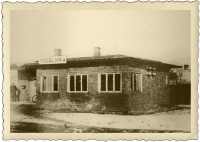 |
| The Station |
"The first inkling we had that something more was being planned in Treblinka was in May 1942, when some SS men arrived with a man called Ernst Grauss who – we found out from the German railway workers – was the chief surveyor at the German District HQ." Zabecki recorded:
"They spent the day looking around and the very next day all fit male Jews in the neighbourhood – about a hundred of them – were brought in and started work on clearing the land. At the same time they shipped in a first lot of Ukrainian guards."
Rumours abounded:
"It was said that it was to be another labour camp, a camp for Jews who would work on damming the River Bug, a military installation, a staging or control area for a new secret military weapon. And finally, German railway workers said it was going to be an extermination camp. But nobody believed them – except me."
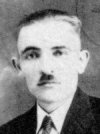 |
| Zabecki |
"Our astonishment was immense," Zabecki commented. "We wondered what sort of settlers they were, where they were going to live and what they were going to do? We connected this news with the mysterious building in the forest."
Zabecki continued:
"The first train to arrive on 23 July 1942 made its presence known from a long way off, not only by the rumble of the wheels on the bridge over the River Bug, but by the frequent shots from the rifles and automatic weapons of the train guards."
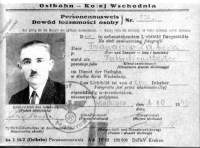 |
| Identity Card |
After the transport arrived, some fiendish spirit got into the SS men; they drew their pistols, put them away, and took them out again, as if they wanted to shoot and kill straight away; they approached the wagons, silencing those who were shrieking and wailing, and again they swore and screamed. Shouting 'Tempo! Schnell', and 'At the double quickly!' to the German railwaymen who had come from Sokolow Podlaski, they went off to the camp, to take over their victims there 'properly'. On the wagons we could see chalk marks giving the number of people in the wagon, viz: 120, 150, 180 and 200 people. We worked out later that the total number of people in the train must have been about eight to ten thousand.
The 'settlers' were strangely huddled together in the wagons. All of them had to stand, without sufficient air and without access to toilet facilities. It was like travelling in hot ovens. The high temperature, lack of air, and the hot weather created conditions that not even healthy, young, strong organisms could stand. Moans, shouts, weeping, calls for water or for a doctor issued from the wagons. And protests: 'How can people be treated so inhumanely? When will they let us leave the wagons altogether?' Through some air gaps terrified people looked out, asking hopefully: 'How far is it to the agricultural estates where we’re going to work?'
Twenty wagons were uncoupled from the train, and a shunting engine began to push them along the spur-line into the camp. A short while later it returned empty. This procedure was repeated twice more, until all sixty wagons had been shunted into the camp, and out again. Empty they returned to Warsaw for more 'settlers'."
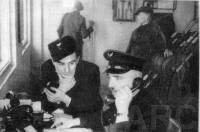 |
| Zabecki at Work - 1943 |
"You must imagine what it was like living here," Zabecki noted. "Every day, as of the early morning, these hours of horror when the trains arrived, and all the time – after the very first days – this odour, this dark foggy cloud that hung over us, that covered the sky in that hot and beautiful summer, even on the most brilliant days – not a rain-cloud promising relief from the heat, but an almost sulphuric darkness bringing with it this pestilential smell."
Zabecki witnessed many acts of savagery at the Treblinka station. Four of these concerned Jews who had tried to escape:
"I saw a policeman catch two young Jewish boys. He did not shut them in a wagon, since he was afraid to open the door in case others escaped. I was on the platform, letting a military transport go through. I asked him to let them go. The assassin did not even budge. He ordered the bigger boy to sit down on the ground and take the smaller one on his knee, then he shot them both with one bullet. Turning to me, he said: 'You’re lucky, that was the last bullet'. Round the huge stomach of the murderer there was a belt with a clasp on which I could see the inscription, 'God with us'."
The second incident took place after a train, arriving late in the evening, had been kept overnight at Treblinka station. On the following morning a Ukrainian Guard "... promised a Jewess that he would let her and her child go if she put a large bribe in his hand. The Jewess gave the Ukrainian the money and her four year old child through the air gap, and afterwards with the Ukrainian’s help, she also got out of the wagon through the air gap. The Jewess walked away from the train, holding her child by the hand; as soon as she walked down the railway embankment the Ukrainian shot her. The mother rolled down into a field, pulling the child after her. The child clutched the mother’s neck. Jews looking out of the wagons called out and yelled, and the child turned back up the embankment again and under the wagons to the other side of the train. Another Ukrainian killed the child with one blow of a rifle butt on its head."
A third incident, witnessed by Zabecki, also took place at Treblinka station:
"One mother threw a small child wrapped up in a pillow from the wagon, shouting: 'Take it, that’s some money to look after it.' In no time an SS man ran up, unwrapped the pillow, seized the child by its feet and smashed its head against a wheel of the wagon. This took place in full view of the mother, who was howling with pain."
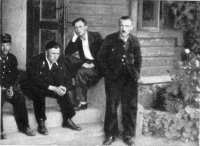 |
| At the Quarters' Door - 1943 |
"There was an SS man from the camp in Klinzmann’s flat. A frightened, battered Jewess who had managed to get out of a wagon came into the station building. She probably thought she would be safe here. Crossing the threshold of the dark corridor close by the door of the German railwaymen’s quarters, she uttered a loud groan and a sigh.
Willi rushed out into the corridor, and seeing the woman he shouted: 'Bist du Jüdin?' ('Are you a Jewess?'). The SS man rushed out after Willi. The frightened Jewess exclaimed: 'Ach mein Gott!' ('Oh My God!'), escaped to the waiting room next to the traffic supervisor’s office, and fell down exhausted near the wall. Both the Germans grabbed the woman lying there. They wanted her to get up and go out with them. The Jewess lay motionless. It was already late evening. As I went out to see to a military transport passing through the station, I shone my lamp on the woman lying there. I noticed she was pregnant, and in the last months of pregnancy at that. The Jewess did not react to the German’s calls uttering groans as if in labour. Then Klinzmann and the SS man from the camp began to take turns at kicking the Jewess at random and laughing.
After dispatching the train, I had to go into the office again through the waiting room, but I could not do it. In the waiting-room a human being, helpless, defenceless, - a sick, pregnant woman – had been murdered. The impact from the hobnailed boots was so relentless that one of the Germans, aiming at her head, had hit too high, right into the wall. I had to go into the office and pass close to the murderers, since the departure of a train to Wolka Okraglik had to be attended to. My entrance made the criminals stop. In their frenzy they had forgotten where they were, and somebody plucked up courage to break in and stop them in their duty of liquidating 'an enemy of Hitlerism'. They reached for their pistols. Willi drunk, mumbled 'Fahrdienstleiter' (Traffic Supervisor). I closed the door behind me. The butchers renewed the kicking. The Jewess was no longer groaning. She was no longer alive."
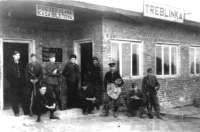 |
| At Treblinka Station - 1943 |
"Trzcinski went up to a wagon, suddenly unfastened his coat, and gave a young Jew a grenade, asking him to throw it among the Germans. The Jew took the grenade, and Trzcinski jumped into the moving passenger train and departed."
Zabecki later learned that the Jew threw the grenade in the death camp at a group of Ukrainians standing besides the Germans on the unloading ramp. One Ukrainian was seriously wounded. The revenge of the Germans and Ukrainians was terrible.
He added:
"The young men were beaten with sticks until they lost consciousness. All of them died."
Zabecki noted that so terrible were the scenes at Treblinka station, that from September 1942 no more passenger trains stopped there, as hitherto: only military trains, and deportation trains being divided up and shunted into the death camp.
He recalled that beyond the railway lines, and parallel to them, ran a concrete road, beyond which was an excavation overgrown with bushes. Fugitives, seeing this thicket, often hid there before fleeing further away. But, 'more often than not', they died there from wounds received as they had jumped from the train: injuries from falling, or shots from the guards. The SS men knew about this, and scoured the thicket with a dog.
As Zabecki’s own allotment was not far from the thicket he witnessed a tragedy on 1 September, as a train of deportees stood in the station, waiting to be shunted forward. Several had managed to break out of the trains and, being shot at all the while, had made for the thicket:
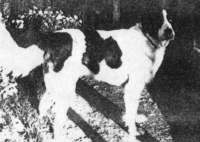 |
| The Dog "Barry" |
The SS man came up to the scene with his gun in his hand. He sensed the dog’s weakness. The dog began to wag its tail, turning its head towards the boots of the SS man. The German swore violently and flogged the dog with his stick. The dog looked up and fled. Several times the German kicked the dead woman, and then began to kick the baby and trample on its head. Later he walked through the bushes, whistling for his dog. The dog did not seem to hear, although it was not far away; it ran through the bushes whimpering softly; it appeared to be looking for the people. After a time the SS man came out on to the road, and the dog ran up to its master. The German then began to beat it mercilessly with a whip. The dog howled, barked, even jumped up to the German’s chest as if it were rabid, but the blows with the whip got the better of it. On the masters command it lay down.
The German went a few paces away, and ordered the dog to stand. The dog obeyed the order perfectly. It carefully licked the boots, undoubtedly spattered with the baby’s blood, under its muzzle. Satisfied the SS man began to shoot and set the dog on other Jews who were still escaping from the wagons standing in the station."
Although much has been said about the brutality of the Ukrainian guards, in Zabecki’s opinion, the Lithuanians, who mostly guarded the trains, were much worse:
"They really were sadists; they used to shoot at people, blind, through the windows of the cars, when they begged for doctors, water and to be allowed to relieve themselves. They did it as a sport – they laughed and joked and bet while they did it. Amongst the Ukrainians there were several who we knew wanted to get away. But you see, that too was dangerous; they were in just as much danger as everybody else."
In fact, nobody was safe. One of Zabecki’s colleagues who was helping him to count cars, Tadeuz Kancakowski, was seen by the Germans putting a note with figures on a spike; two German civilians came and took him to Malkinia. He was sent to Majdanek, and perished there."
The only surviving witness who was present at Treblinka from the very first day that the extermination camp began operations until the very last was in no doubt about the number of victims:
"I know," Zabecki stated, "the others guess. There were no German papers on which to base these estimates except those I rescued and hid – and they are inconclusive. But I stood there in that station day after day and counted the figures chalked on each carriage. I have added them up over and over and over. The number of people killed in Treblinka was 1,200.000, and there is no doubt about it whatsoever."
On 6 August 1944, when the front was very close to Treblinka and the railway station was already closed to traffic and even to railway workers, Franciszek Zabecki, knowing that the station building would be destroyed, smuggled out of there some of the railway documentation concerning the traffic of transports to the death camp. A few minutes later, when Zabecki was in the surrounding fields, the building of the railway station was destroyed by the Germans. Several days later, neighbouring villages around Treblinka were burned by the Wehrmacht and the local population were forced to escape to a different region. On 16 August 1944, Treblinka was liberated by the Soviets.
In September 1944, Zabecki went back to his work at the railway station in Treblinka. In autumn 1945 the Main Commission for the Investigation of Nazi Crimes from Warsaw organized an investigation in Treblinka. The investigators were under the supervision of Zdzislaw Lukaszkiewicz, a famous Polish judge and a specialist concerning Nazi crimes in Poland (for example, he was the supervisor of the investigation into KZ Majdanek). During an interview conducted by Lukaszkiewicz, Zabecki decided to give to the judge the originals of the documents which he had taken from the Treblinka station. Shortly after the war the original documentation was deposited at the Siedlce court and copies were taken to the Main Commission Office in Warsaw, where they remain to this day.
20 years later, in 1965, Zabecki was invited to Düsseldorf as a witness in the first trial of former SS men from Treblinka: Kurt Franz, August Miete, Arthur Matthes, Willi Mentz, Gustav Münzberger, Otto Stadie, Franz Suchomel, Erwin Lambert, Otto Rum and Otto Horn. Prior to his journey to Germany, Zabecki had many doubts about going there. He was concerned about the reception of his memoirs from the “other side”, but he wanted to bear witness to all of the crimes he had seen. During the first confrontation with former SS men he could not recognize any of them:
“The judge asked me if I knew the accused, if I recognized them and what were their names. Horrible. In the main it had been twenty-two years since I had last seen them. I saw the younger men of that time. Now they were old men, some of them grey haired, others bald, their faces wrinkled. Also important was the fact that as younger men they had been in uniform. Now they were in civilian clothing. I stood because I wanted to see them better. We stood for a time opposite one another. I looked at everybody. I looked into their eyes for a few seconds before they looked away; in these short seconds I was the object of their hate-ridden, yet at the same time, interested scrutiny. I felt that they tried with difficult to recognize who it was from the Polish railway workers who stood before them.”
When the judge started to call the accused by name, Zabecki immediately recognized them. During the trial he was asked for details connected with the transports and for the documentation that he had saved. In the course of this visit to Germany, Zabecki also met Miriam Novitch first time in his life, to whom he gave an interview in Polish. He was also interviewed by German and English journalists.
His second visit to Germany was in connection with the trial of former SD men from Bialystok responsible for the liquidation of the ghetto there, as well as mass crimes committed against Polish inhabitants during the occupation. The trial was held in 1966, in Bielefeld. The accused were Wilhelm Altenloh, former commandant of the Security Police and SD in Bialystok, Lothar Heimbach, Heinz Errelis and Richard Dibus. At that time Zabecki testified about the schedule of transports from Bialystok to Treblinka. He also explained about how he had saved the documentation from the railway station in Treblinka and why he had kept records about the transports:
“I was a member of the Home Army and supplying evidence about the transports was my duty. The messages about the crimes in Treblinka were sent to London.”
In 1968, Zabecki travelled to Frankfurt am Main, where the trial of Adolf Beckerle, former Nazi ambassador to Bulgaria, and Fritz von Hahn, an official from the Judenreferat in the Nazi Foreign Ministry, had been scheduled. Among the documents which Zabecki had saved were telegrams about transports from Salonika and Bulgaria. Concerning the question “from what source did the witness know that among the deportees were also Jews from foreign countries?” he answered:
"The Jews from foreign countries arrived in passenger trains and had bought tickets for the journey. The train staff collected the tickets and gave them to us at the railway station. The tickets were the best proof of the country the deportees were from. Sometimes a passenger would ask the Polish railway workers how far it was to the factories in Treblinka, because his whole family was there already. One passenger decided to go to the bar while his transport stood at a station en-route, and the train with the deportees left without him. He used the normal train service and arrived at Treblinka, wanting to be with his family. During our conversation he told me where he was from and I informed him in detail about the “factories” in Treblinka. He escaped immediately. There were several such incidents. Every train had a list of wagons. On these lists was the departure station of the transport.”
As a result of this trial von Hahn was sentenced on 8 years imprisonment. Beckerle was released because of ill health and was never sentenced.
The last time Zabecki appeared as a witness at a trial was at the proceedings against Franz Stangl in Düsseldorf in 1970. At the trial Zabecki provided a detailed statement, not only about the transports and the camp, but also about his activity in connection with the gathering of information for the Home Army. He also mentioned eng. Kaczkowski:
“Eng. Kaczkowski was very well known to me at that time. He cooperated with me in completing our knowledge about the transports. After his arrest every trace of him was lost. Eng. Kaczkowski’s colleagues told us that he was deported to some concentration camp.”
In providing his evidence, Zabecki was asked if Stangl had visited the railway station in Treblinka. He confirmed this fact and also described how Stangl had visited local villages when Ukrainian guardsmen escaped from the camp. This was a very important moment for the court, because prior to Zabecki’s evidence, Stangl had denied that he was the commandant of Treblinka and had stated that he was not in the camp at the time of the mass murders. During this trial Zabecki had a second occasion to meet Miriam Novitch. He also had a very long conversation with Berek Rojzman, a survivor from Treblinka.
See Revolt in Treblinka and the Liquidation of the Camp - by Franciszek Zabecki
Sources:
Gilbert, Martin. The Holocaust – The Jewish Tragedy, William Collins Sons & Co. Ltd., London, 1986.
Sereny, Gitta. Into That Darkness – From Mercy Killing to Mass Murder, Pimlico, London, 1995.
Zabecki, Franciszek. Wspomnienia dawne i nowe, Warszawa, 1977.
© ARC 2005